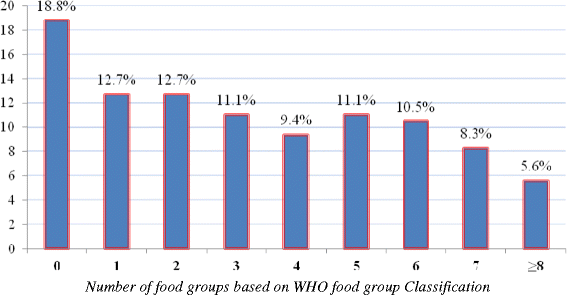Complementary feeding practices and associated factors among HIV positive mothers in Southern Ethiopia
- PMID: 26825277
- PMCID: PMC5026011
- DOI: 10.1186/s41043-015-0006-0
Complementary feeding practices and associated factors among HIV positive mothers in Southern Ethiopia
Abstract
The objective of this study was to assess complementary feeding practices and associated factors among HIV exposed infants in Sidama Zone, Southern Ethiopia. An institutional based cross-sectional study with cluster random sampling technique was employed and all HIV exposed infants aged 6-17 months found in randomly selected health institutions in Sidama zone, Southern Ethiopia were included. A 24-hour dietary recall and 7-day quasi-food group frequency was used to assess complementary feeding practices. The prevalence of timely initiation of complementary feeding (6-8 months) was 42% [95% CI: (30-54%)]. Of all the HIV exposed infants aged 6-17 months, 40.7% had practiced bottle-feeding. About 65.6% and 53.3% of HIV exposed infants did not receive the recommended number of food groups and frequency of complementary feeding in the last 24 hours respectively. Pulse (plant protein) was consumed by only 22.5% of the infants while only 9.9% of the infants consumed animal source food in the last 24 hours. Presence of infant food prohibition (β = -0.342, P = 0.001) and age of the infant (β = 0.311, P = 0.001) were found to be an independent predictors of dietary diversity. Presence of infant food prohibition (β = -0.181, P = 0.02) and age of infant (β = 0.388, P < 0.001) were also the predictors of 24 hour meal frequency. Having lower educational status [AOR = (0.21, 95% CI (0.062-0.71)] was an independent negative predictor of bottle-feeding practice. Many of the complementary feeding practices like meal frequency; dietary diversity and bottle-feeding were sub-optimal. Nutrition education should be designed for improving complementary feeding practices of HIV exposed infants in Sidama Zone, Southern Ethiopia. Mothers with higher educational status should be also targeted for nutrition education especially on bottle feeding practice.
Figures


References
-
- WHO. Ua: Global Strategy: Breastfeeding critical for child survival. Available at: http://www.who.int/mediacentre/news/releases/2004/pr19/en/(date accessd May 25, 2011) 2004.
-
- WHO/UNAIDS/UNFPA/UNICEF: Guidelines on HIV and infant feeding, Principles and recommendations for infant feeding in the context of HIV and a summary of evidence. Available at: http://whqlibdoc.who.int/publications/2010/9789241599535_eng.pdf (date accessd May 17, 2011). 2010. - PubMed
-
- World Bank: HIV/AIDS, nutrition, and food Security: what we can do. A synthesis of international Guidance 2007 pp 30-33. Available at: http://siteresources.worldbank.org/NUTRITION/Resources/28184611000084313... (date accessed August 29, 2011). 2007.
-
- WHO: Guidelines for an integrated approach to the nutritional care of HIV-infected children (6 months-14 years) at HIV treatment sites / referral centers. Draft hand book. Geneva, Switzerland. Available at: http://www.unicef.org/aids/files/hiv_6mth-14yr_Handbook.pdf (date accessed December 17, 2012). 2007.
Publication types
MeSH terms
LinkOut - more resources
Full Text Sources
Other Literature Sources
Medical

